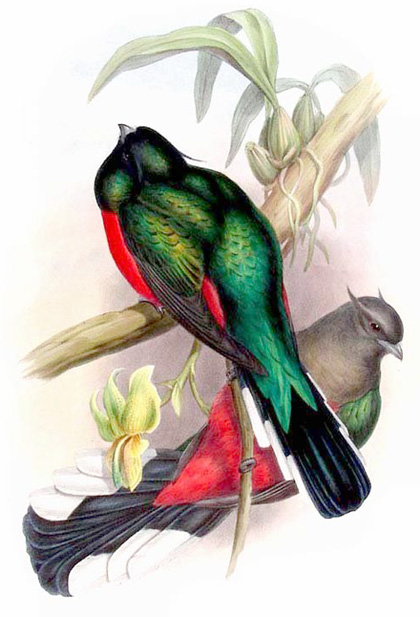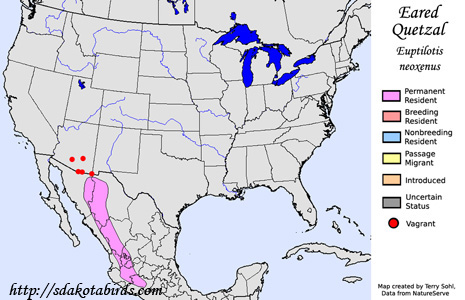Eared Quetzal
Euptilotus neoxenus
| Length: 14 inches | Wingspan: 24 inches | Seasonality: Non-resident in South Dakota |
| ID Keys: Dark greenish upperparts, bright red belly, small grayish head, green chest (male), gray chest (female) | ||
 The
Eared Quetzal was recently named the Eared Trogon, but research has shown
they are much more closely related to Quetzals than Trogon species.
They are primarily found montane forests of western Mexico, but beginning in
1977, tiny numbers of the species have been found in canyon forests of
southern Arizona. Confirmed breeding has also occurred in select
locations of southern Arizona. While the species is similar in overall
structure as the Elegant Trogon,
another tropical specialty with a range that barely overlaps into the United
States, the Eared Quetzal is quite a bit larger, has a much smaller-looking
head, and has obvious plumage differences.
The
Eared Quetzal was recently named the Eared Trogon, but research has shown
they are much more closely related to Quetzals than Trogon species.
They are primarily found montane forests of western Mexico, but beginning in
1977, tiny numbers of the species have been found in canyon forests of
southern Arizona. Confirmed breeding has also occurred in select
locations of southern Arizona. While the species is similar in overall
structure as the Elegant Trogon,
another tropical specialty with a range that barely overlaps into the United
States, the Eared Quetzal is quite a bit larger, has a much smaller-looking
head, and has obvious plumage differences.
Habitat: In the main part of their range in Mexico, the Eared Quetzal is found in mid- to high-elevation forests, typically pine-oak forest or in conifer forests. Those that have been found in the United States have been in several forested, mountain canyons.
Diet: Insects make up a large part of the diet, especially large insects and caterpillars. They will also take small vertebrates when available. They also feed heavily on fruits and berries, especially in the winter when insects may be less abundant.
Behavior: Eared Quetzals appear to be rather sensitive to disturbance around nest sites, with evidence that human activity near nesting sites can contribute to nest failure. Otherwise, behavior is similar to other Quetzals and Trogons, with birds often acting relatively lethargic.
Nesting: In the U.S. part of their range, nests have typically occurred in old woodpecker cavities, usually in tall trees near flowing water in forested canyons. Eggs are incubated by both parents, and both parents help to raise the young.
Song: Song of the Eared Quetzal is a series of whistles which consistently rise in pitch and strength.
Migration: Eared Quetzals are considered to be permanent residents throughout their range. However, there are some indications that birds do move to lower elevations in Mexico during the winter.
Interactive eBird Map: Click here to access an interactive eBird map of Eared Quetzel sightings
Similar Species: In the U.S. part of its range, Elegant Trogons are similar in structure, but size and plumage are quite different.
Conservation Status: Eared Quetzals are currently considered "near threatened", due to an overall small population and the threat of potential habitat loss. However, current populations are likely stable.
Further Information: 1) Cornell's Neotropical Birds - Eared Quetzal
2) BirdLife International - Eared Quetzal
3) AvianWeb - Eared Quetzal
Image Information: Hand-colored lithograph - John Gould, 1861. Public Domain image, copyright expired in United States.
Additional Photos: Additional Photos Coming Soon!!
| Click below for a higher-resolution map |
 |
| South Dakota Status: Non-resident in South Dakota |
Additional Eared Quetzal Photos (coming soon!!)
